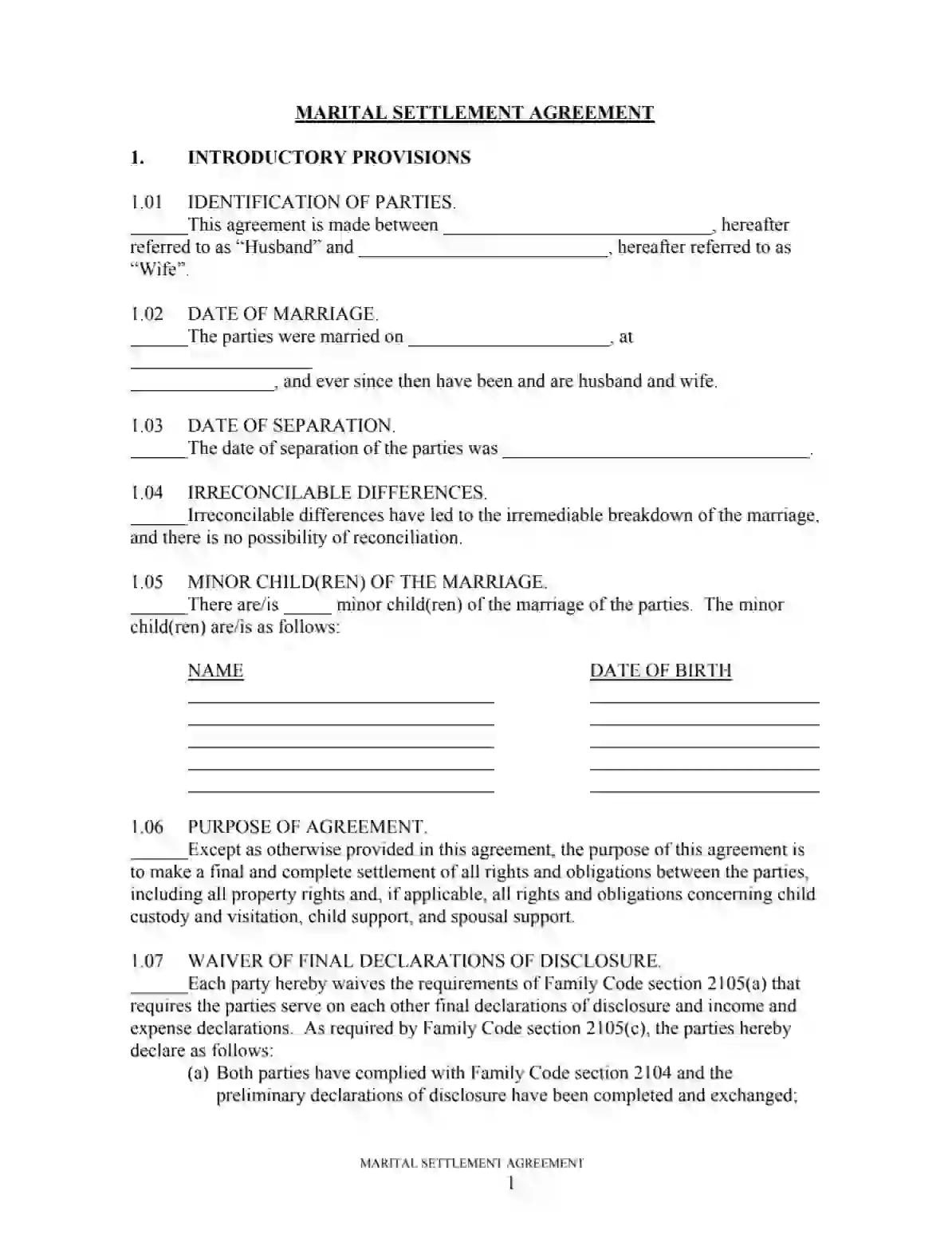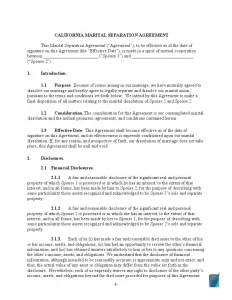California Marital Settlement (Divorce) Agreement and Legal Separation
Unfortunately, many married couples in the United States and California particularly eventually get divorced. Some legal forms follow such cases because an ex-husband and ex-wife need to define their post-marriage relationship. One of these documents is the California marital settlement agreement.
According to state statistics, almost three million Californian residents are divorced. Most likely, when they filed for a divorce, they had common properties, and plenty of couples have had at least one child together. The marital settlement agreement helps to establish a set of rules regarding the future actions of both parties, splitting of property, child care, and so on.

Build Your Document
Answer a few simple questions to make your document in minutes
Save and Print
Save progress and finish on any device, download and print anytime
Sign and Use
Your valid, lawyer-approved document is ready
While some couples split up with scandals and hysterics, others approach the issue reasonably, without drama. There are mediators for the first type of couples—specialists that help create contracts between spouses if their communication is hampered.
When parties sign the agreement, they should act in conformity with its conditions. Otherwise, various penalties included in the document may follow.
Overall, each marital settlement agreement should contain the following sections and items:
- Introduction. The first part reveals the spouses’ names, the date when they got married and broke up financial disclosure, and minor children’s presence. Also, in the introduction, a couple should indicate if one of the spouses is in military service.
- Spouse support and property information. If an ex-spouse plans to support the other financially in the future, the couple should specify this information. Then, the couple must also describe their properties and liabilities, decide who covers the insurance (either one of the spouses or both), state they will change their legal name, and follow other agreement statements to define more conditions.
- Additional conditions section. Both parties can talk through and add miscellaneous conditions to the agreement after the given template sections are filled out.
- Signatures. The spouses have to accept the listed terms, sign the record, and date it. Both of them should also duplicate their names.
- Supplements. Because some data should be described in detail, an agreement usually has several attachments. The first one is dedicated to the couple’s minor children and future children (if an ex-wife is pregnant while the divorce is happening). This supplement describes all the terms regarding child care, from financial support to the schedule of each parent’s visits.
Other attachments contain a comprehensive description of the spouse’s support, parties’ estate, and debts.
The agreement is not effective until both parties append their signatures on it. Another compulsory thing is to notarize the record. Remember that without the agreement, you will not be able to finish the divorce procedure successfully.
If you need to complete the California marital settlement agreement and seek a proper file to fill out, use our advanced form-building software. With it, you will obtain a suitable template easily and quickly.
In the US, all states have their provisions and norms regarding marriages and divorces. To determine which legislature is applicable in California when people officially split up and cancel their marriage, proceed to the next part.
California Divorce and Separation Laws
If a couple decides to divorce, it should act in line with the California Family Code ( FAM). Starting from Division 6 of the Code, you can find all details about splitting up, legal child care, and other provisions.
Grounds for Divorce
According to Section 2310 (Division 6) of the Code, there are two main reasons to get divorced: either impossibility to solve implacable divergence or the incapacity of a spouse (constant and leads to an inability to make decisions). Sections 2311, 2312, and 2313 give more details on those reasons.
Property Division
Division 7 of the Family Code describes the process. The court has to split the properties into equal shares for both parties if the couple does not agree on a different way of splitting, as stated in Section 2550.
Child Custody and Visitation
Division 8 of the Family Code regulates custody in California and protects children’s interests. It incorporates provisions about visiting the child, joint custody, birth parents’ and stepparents’ rights, and other relevant matters.
Generally, the court has to allow birth parents to visit their kids for the kids’ best (Section 3100). Both parents have equal rights to care about their child (or children) after the divorce, as written in Section 3010.
Child Support and Alimony
This topic is covered in Division 9 (Part 2) of the Code. Besides laws describing the minors’ support, it offers regulations about the grandchildren and children who are already adults (over 18 years old by law). Section 3900 makes both parents responsible for the support.
Popular Local Marital Settlement Agreement Forms
A divorce settlement agreement, often known as a mediated separation agreement, is a great document that could enable you to negotiate the divorce process and avoid pointless stress. Below are the states where people search for this form the most.
Legal Separation
Legal separation allows couples to live separately without divorce. The key feature of such status is that husbands and wives remain married. However, they do not share a home. It makes some operations and children custody more convenient, and the perks spouses have will still apply.
Another reason is religions that do not endorse divorces or uncertainties because of the potential divorce.
Some states do not suggest this status for couples, but in California, it is lawful. The provisions regulating the topic are incorporated in Division 6, Part 3, Chapter 2 of the Family Code.
The grounds for such separation are the same as for divorce (Section 2310). The procedure is similar to a divorce; however, couples should form and sign a Separation Agreement form.

Filing for Divorce in California
If you and your partner have thought through all pros and cons of a divorce and decided to terminate your marriage, check our comprehensive guidelines on actions you need to accomplish in California.
To begin the process, you have to apply to the Superior Court in California (the one in your county) and cover a significant fee of 435 US dollars. The results will arrive no earlier than half a year after applying and completing all the steps listed below.
1. Create a Petition
One of the spouses should fill out a petition (or form FL-100). This record describes the relationship between partners, reasons for splitting up, basic information about the marriage or partnership, children, assets, and other details.
2. Fill out Children-related Forms
If partners have kids who are still considered minors, there are additional papers to complete and sign. Forms FL-105 and FL-311 will propose parents’ views on custody, support, visitations, and other actions tied to the children’s upbringing.
3. Submit Your Application to Court
The next step would be to submit the forms to court and officially start the divorce process. A court clerk, a lawyer dealing with family matters, or a self-help center specialist will advise on additional legal papers that you possibly have to submit.
Then, a clerk will accept your application. You will be given stamped copies as evidence of your submission.
Remember that you should pay a fee. In case you cannot afford it, the court may release you from this obligation. To request this, file the form FW-001.
4. Deliver the Documents to Your Partner
Your partner has to receive the forms you have submitted. They can be delivered by the local sheriff, a process server, or anyone else who is an adult by law.
There should be a reaction from your partner. They will get two templates to complete: FL-120 and FL-105. By signing these papers, your partner shares their views on assets splitting and child care. They also indicate whether they want a court to make decisions or not.
The one who delivers the forms should get proof of your partner’s acknowledgment—a signed form FL-117. This record should also be given to the court, among other documents.
5. Share the Details about Your Finances
Once you have submitted the forms, you and your partner have two months to share information about your funds and properties. This is done by filling out the legal forms FL-150, FL-160, FL-140, and FL-142. These records tell about the current earnings and costs, liabilities, and estate of both partners.
The forms are not valid without proof: tax returns of each partner submitted within the last two years. Both partners should receive each other’s forms and then fill out form FL-141. Each person has to prepare at least two copies of it. Then, the documents and the copies go to court.
6. Create the Marital Settlement Agreement
We have already explained the content of this agreement and the need to create it. Spouses should mutually discuss the conditions related to child care, properties, and future support and add all provisions to the form.
After making the agreement, both parties must sign it. Notarization is mandatory.
7. Fill Out Other Templates
There are more templates to fill out. Among them are FL-130, FL-170, FL-180, FL-190, and FL-144. Define which templates are suitable for your case and fill them out. When all forms are ready, file them in court.
In case partners seek a judgment in court for any matters concerning their children, spouse support, or properties, they should contact the clerk to see which additional forms to fill out. The list consists of more than ten templates (FL-341, FL-191, FL-195, and others); you might need to complete all of them.
8. Wait for the Judgement
Finally, after creating and signing all the required papers, send them to the judge and wait for their decision.
Sometimes one of the partners needs to change their name. This is a different procedure that is completed after the divorce.

Need some other California forms? We offer free forms and straightforward personalization experience to everyone who wants having fewer to none issues when confronted with paperwork.
Other Marital Settlement Agreement Forms by State